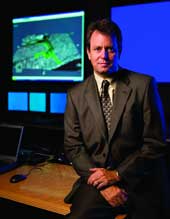Talk about an evolution

Future Combat Systems and WIN-T draw a technology road map for tomorrow's warriors.
Unattended ground sensors that provide surveillance and robots that clear buildings without putting soldiers in harm's way are just two small pieces of the Army's overall plan to modernize its forces.Those two technologies, recently tested in a live-fire exercise, illustrate how the Future Combat Systems program is trying to build a cohesive system of systems. In conjunction with the fledgling tactical communications backbone ? the Warfighter Information Network-Tactical ? the FCS program is a road map of how the Army and other U.S. forces plan to evolve in the next decade.Technology companies that want to work with the Army and its systems integrator partners should pay close attention to FCS and WIN-T so they stay relevant to the two modernization efforts.When a TeleCommunication Systems Inc.'s intelligence customer wanted a briefcase-size satellite communications system that integrated a credit card-size encryption card, the company built the system in weeks rather than years.The speed of that project illustrates the pace at which technology is evolving and how quickly government customers want to deploy it, said Michael Bristol, senior vice president of the company's Government Solutions Group.The company was one of six that won the Army's $5 billion World-Wide Satellite Systems contract in 2006. The program is jointly managed by WIN-T and the Defense Communications and Army Transmission System.The Defense Communications and Army Transmission System provides long-haul connectivity for soldiers. The program provides the bandwidth required for the Global Information Grid."The technology is constantly attacking three or four different variables: size, cost and throughput," Bristol said. "More capable equipment that requires less logistics, is easier to transport and gives you more throughput is what you're working for."The technology is changing so quickly that the World-Wide Satellite Systems contract is designed for rapid acquisitions. That's something systems integrators must pay attention to, Bristol said."You've got to be very fast," he said. "You've got to be able to rapidly prototype and build quickly. And the new technology has to be downwardly compatible with what already exists."Compatibility is one of the cornerstones of the Combined Endeavor exercise that brings together more than 40 countries annually to see how well their systems interoperate.The exercise connects devices and networks from dozens of military forces and illustrates how the United States will likely build out WIN-T and the Joint Network Node, said Pat Ryan, director of Cisco Systems Inc.'s Defense Group. Cisco helped build the exercise's IP network."Using IP and enabling all the applications to connect over an IP-enabled backbone, they were able to get up and operating with 24 hours of initiating Combined Endeavor," Ryan said.Cisco is working with General Dynamics Corp., Harris Corp. and other companies on WIN-T and JNN. Cisco helped combine mobile technologies with a radio router interface to create an ad hoc battlefield network."The hardest part is combining all the different stovepiped networks that existed," Ryan said. "And with applications that were built for specific platforms and uses, it is a challenge combining all those into a battlefield situation that works."As with Combined Endeavor, the answer to that challenge appears to be IP-enabling every device on the battlefield. Every plane, truck, ship and soldier will use IP-based devices.Because the systems are so complex, Ryan recommends that systems integrators and government customers seek out technology companies with expertise in each specific component of the project."Rather than build a network, use commercial companies to build commercial off-the-shelf gear and let those capabilities shine," he said. "If you can use a commercial item that is IP-enabled, using international standards and it satisfies 85 percent of your requirements, do it. And then figure out what you need to do separately to meet the rest of the requirements. But don't start from scratch."Battlefields are always changing, so a critical part of FCS and WIN-T is to create hardware capable of taking new networks and technology into the field.BAE Systems Inc., for example, built communications payloads composed of the Joint Tactical Radio and Ground Mobile Radio systems under the Army's FCS program. BAE delivered the systems to Boeing Co., lead systems integrator for FCS.Under the program, the Army plans to deploy software-programmable radios on Abrams tanks, Bradley Combat Systems and Humvees.BAE Systems provides electronic and mounting hardware, the radio's antenna and integration services for the Ground Mobile Radio system.Ground Mobile Radio is a joint-services initiative to provide a family of software-programmable radios that provide reliable, multichannel voice, data, imagery and video communications for mobile military users. The system is designed for compatibility with future communications waveforms and links and also for backward compatibility with existing systems.When a vehicle with a programmable radio joins a new team or organization, the network the radio is on can be quickly changed, said Hank Waters, a BAE senior program manager for FCS."We built a rather sophisticated multiband antenna so multiple radio frequencies can be used off the same antenna," Waters said. "If you look at the vehicles in Iraq today, you can almost identify them by the number of antennas that are on top."A vehicle with only one antenna is a less enticing target for enemy forces than a vehicle with multiple antennas."It also gives much greater capability to the soldiers when they're in the field because they can join other networks as they join a different unit," said Jerry Garretson, a BAE director of Integrated Network Solutions. "They don't have to change hardware radios."Once military networks are established, applications are needed to assist warfighters with their jobs. General Dynamics C4 Systems, for example, is developing the Command Post of the Future for the Army under an initial $18.4 million contract.CPOF is a software application built on General Dynamics' CoMotion product, which supports visualization, information analysis and collaboration. It is designed to help commanders and decision-makers analyze information, share thoughts and evaluate courses of action."The goal of the CPOF application is really focused on the commander and his staff and allowing the commander to really collaborate deeply with his staff," said Don Schmidli, General Dynamics C4 Systems' director of battle command and sensor systems. "By that I mean connecting more on an intellectual understanding of what's going on rather than just passing information around."The application enables collaboration on any task facing commanders. If one person is using data in a spreadsheet and another person revises that data, the spreadsheet is automatically updated.If a commander in another location is planning a mission, the data about previous attacks is crucial. So working with live data is much more effective than working from old reports or a string of old messages.If the people working on the attack analysis update their information, the person planning the mission can easily take that new data into account.CoMotion makes it possible to see data in different formats, such as maps."For example, the person working on [improvised explosive device] analysis may be looking at a map, but he might also grab all those icons off a map and drag them into a spreadsheet or graphing tool," Schmidli said. The data remains connected regardless of how the user views it.Another opportunity for technology companies under the FCS contract is training. The system's network is being designed to enable soldiers to train anywhere at any time.Although it is not under the FCS program, L-3 Communications Inc.'s L-3 Link Simulation and Training division developed an advanced helmet-mounted display system that customers such as the U.S. Army Flight School use for training.The system is more advanced than a simple video screen mounted on a helmet, said Lenny Genna, L-3 Link's vice president of Army programs."The helmet-mounted display technology is married with something called the head tracker, which determines where you're looking," Genna said. "So as you move your head, the image rebuilds based on what you would see from that perspective."For example, a pilot can look toward the back of a plane simulator and see other planes flying behind him.A fiber-optic cable tethers the helmet display to an inertial-acoustic helmet-tracking system. The tracking system provides the positioning data when the pilot turns his head and enables the helmet to project the correct computer-generated scene.Wireless helmets might be possible in the future, Genna said.



A NEED FOR SPEED
THE 85 PERCENT SOLUTION
STRETCH THE NETWORK
TOOLS TO COLLABORATE
DON'T FORGET TRAINING
Staff writer Doug Beizer can be reached at dbeizer@1105govinfo.com.

Michael Bristol, TeleCommunication Systems Inc.

"Rather than build a network, use commercial companies to build commercial off-the-shelf gear and let those capabilities shine." ? Pat Ryan, Cisco Systems Inc.

Don Schmidli, General Dynamics C4 Systems
A NEED FOR SPEED
THE 85 PERCENT SOLUTION
STRETCH THE NETWORK
TOOLS TO COLLABORATE
DON'T FORGET TRAINING
Staff writer Doug Beizer can be reached at dbeizer@1105govinfo.com.
NEXT STORY: Budget battles could trigger funding delays